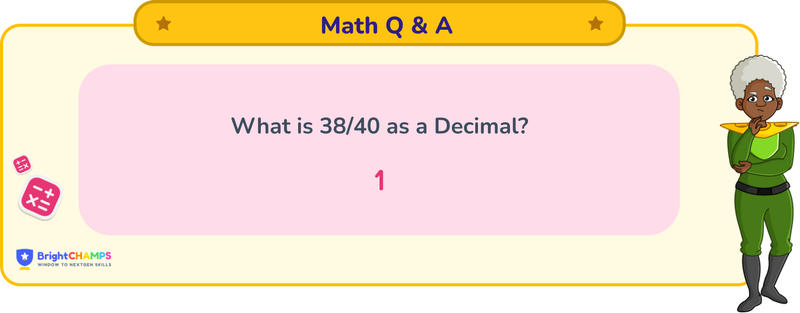
 177 Learners
177 LearnersLast updated on May 26th, 2025

38/40 as a Decimal

It is a simple question on decimal conversion. To convert a fraction to a decimal, you must understand the relationship between fractions and decimals. A fraction represents a part of a whole and consists of two parts: the numerator (the number on top), which indicates how many parts are being considered, and the denominator (the number below), which shows how many parts make up the whole. A decimal is a representation of a number that is not whole, using a decimal point (.) to separate the whole number part from the fractional part. The numbers to the left of the decimal point represent the whole, while those to the right represent the fractional part.
What is 38/40 as a decimal?

Answer
38/40 as a decimal can be written as 0.95. It is a terminating decimal, meaning it does not repeat infinitely.
Explanation
To convert 38/40 into a decimal, we will use the division method. Since 38 is less than 40, it helps to understand the division process. Let's see the step-by-step breakdown of the process:
Step 1: Identify the numerator and denominator. The numerator (38) will be taken as the dividend, and the denominator (40) will be the divisor.
Step 2: Divide 38 by 40. As 38 is less than 40, we can directly perform the division.
Step 3: Perform the division: 38 ÷ 40 = 0.95. Since 38 divided by 40 results in 0.95, we have a terminating decimal.
This process is straightforward, and the result is 0.95.
Important Glossaries for 38/40 as a decimal
- Fraction: A numerical quantity representing a part of a whole, consisting of a numerator and a denominator.
- Decimal: A representation of a number using the base ten, including a decimal point to separate the whole part from the fractional part.
- Numerator: The top part of a fraction, indicating how many parts of the whole are being considered.
- Denominator: The bottom part of a fraction, showing how many parts make up a whole.
- Terminating Decimal: A decimal that ends and does not repeat infinitely.




